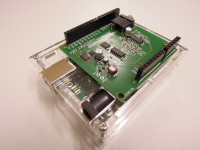Software Defined Radio (SDR) shield for Arduino [150515-1]

This shield is based on the extremely popular SDR-project published in the May 2007 issue of Elektor Electronics. The original author Burkhard Kainka also made this new design, now as a shield for an Arduino Uno (-based) microcontroller board. The antenna preselector section was omitted and the CY27EE16 programmable oscillator replaced by a SI5351 from Silicon Labs.
The first prototypes are built and tested and it looks like only some firmware tweaks are needed to finish this project!



Updates from the author